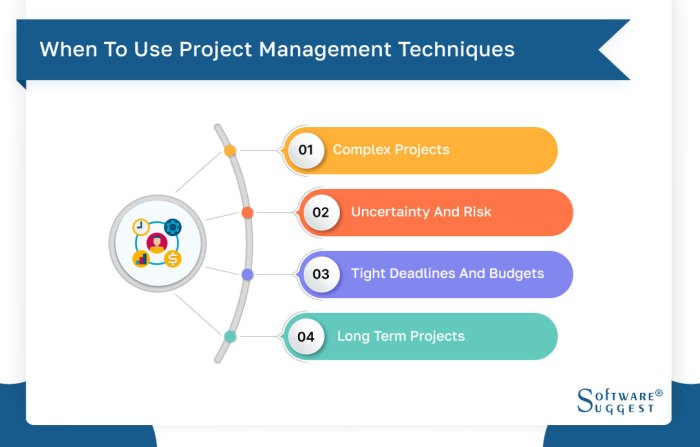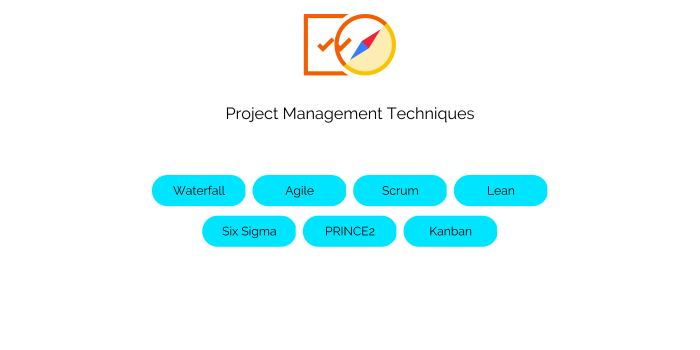Project Management Techniques take center stage in this guide, giving you a sneak peek into the dynamic world of successful project delivery. Get ready for a rollercoaster ride of strategies and insights that will keep you on the edge of your seat!
From traditional methods to agile approaches, we’ve got you covered with everything you need to know about mastering the art of project management techniques.
Overview of Project Management Techniques

Project management techniques are a set of tools, skills, and processes used to plan, execute, and monitor projects effectively. They are crucial for ensuring that projects are completed on time, within budget, and according to specifications. By utilizing various project management techniques, project managers can streamline workflows, allocate resources efficiently, and mitigate risks, ultimately leading to successful project outcomes.
Popular Project Management Techniques
- Agile Methodology: A flexible approach that emphasizes collaboration, adaptability, and iterative development. It is commonly used in software development projects.
- Waterfall Method: A linear and sequential approach where each phase of the project must be completed before moving on to the next. It is often used in construction projects.
- Scrum Framework: An iterative and incremental framework that focuses on delivering value quickly. It is widely used in product development projects.
Application of Project Management Techniques
Different project management techniques can be applied based on the nature and scope of the project. For instance, complex and innovative projects may benefit from Agile methodology due to its adaptability and ability to respond to changes quickly. On the other hand, projects with well-defined requirements and strict deadlines may be better suited for the Waterfall method. Understanding the unique needs of each project is essential in selecting the most appropriate project management technique for optimal results.
Traditional Project Management Methods
Traditional project management methods, such as Waterfall and Critical Path Method (CPM), have been widely used in various industries to plan, execute, and monitor projects.
Waterfall Method
The Waterfall method follows a linear and sequential approach, where each phase of the project is completed before moving on to the next. This method is best suited for projects with well-defined requirements and clear objectives.
- Initiation: Define project goals and scope.
- Planning: Create a detailed project plan.
- Execution: Implement the project plan.
- Monitoring & Controlling: Track progress and make necessary adjustments.
- Closing: Formalize project completion and handover.
Critical Path Method (CPM)
CPM is a technique used to determine the longest sequence of dependent tasks in a project, helping to identify critical activities that could delay the project if not completed on time.
By identifying the critical path, project managers can focus on managing those tasks to ensure the project stays on track.
- Activity Definition: Identify all project activities.
- Activity Sequence: Determine the order of activities.
- Activity Duration: Estimate time required for each activity.
- Critical Path Analysis: Identify the longest path of dependent activities.
Comparison with Agile Approaches
Traditional project management methods are often characterized by their rigid structure and emphasis on detailed planning upfront, while agile approaches prioritize flexibility, collaboration, and continuous improvement.
- Waterfall focuses on thorough planning, while agile allows for iterative development.
- CPM emphasizes critical path analysis, whereas agile values adaptability to change.
- Traditional methods work well for projects with stable requirements, while agile is better suited for dynamic environments.
Real-World Examples
Successful projects managed using traditional methods include the construction of large infrastructure projects like bridges, highways, and buildings, where the scope and requirements are well-defined from the start.
Agile Project Management Techniques
Agile project management is a modern approach to managing projects that focuses on flexibility, collaboration, and delivering value to customers in a timely manner. The core principles of Agile include responding to change over following a plan, customer collaboration over contract negotiation, working product over comprehensive documentation, and individuals and interactions over processes and tools.
Scrum
Scrum is an Agile methodology that involves working in sprints, usually lasting 2-4 weeks, to deliver incremental improvements to a project. It emphasizes daily stand-up meetings, sprint planning, sprint review, and sprint retrospective to ensure continuous improvement and adaptability.
Kanban
Kanban is another Agile methodology that focuses on visualizing work on a Kanban board, limiting work in progress, and continuously improving the flow of work. It allows teams to prioritize tasks, identify bottlenecks, and optimize their process for efficiency.
Extreme Programming (XP)
Extreme Programming is an Agile methodology that emphasizes continuous feedback, frequent releases, pair programming, test-driven development, and simple design. It aims to improve software quality and responsiveness to changing requirements through close collaboration between developers and customers.
Benefits and Challenges
- Benefits of Agile project management include increased flexibility, faster delivery of value, improved collaboration, and better adaptation to changing requirements.
- Challenges of implementing Agile techniques may include resistance to change, difficulty in estimating project timelines, and the need for highly collaborative and self-organizing teams.
Hybrid Project Management Approaches

Hybrid project management is a methodology that combines elements of both traditional and Agile project management approaches to tailor a unique strategy that fits a specific project’s needs.
Scenarios for Hybrid Approach
Here are some scenarios where a hybrid project management approach may be more suitable:
- When the project requires a structured approach for certain aspects but also needs flexibility and adaptability in other areas.
- When there are fixed deadlines and budgets to adhere to, but the project scope is subject to change.
- When the project team consists of individuals with varying levels of experience and skillsets, requiring a mix of guidance and autonomy.
Tips for Implementing Hybrid Techniques, Project Management Techniques
Here are some tips for effectively implementing hybrid project management techniques:
- Clearly define the project scope, objectives, and deliverables to ensure all team members are aligned.
- Regularly communicate with stakeholders to provide updates on progress, changes, and challenges.
- Utilize Agile practices such as sprints, stand-up meetings, and retrospectives to foster collaboration and feedback.
- Adapt the project management approach as needed based on feedback, results, and evolving project requirements.
